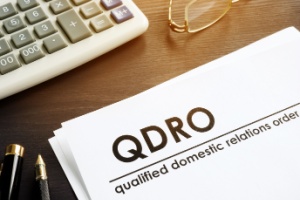
What is a Qualified Domestic Relations Order (QDRO) and how are Retirement Accounts Divided in Divorce?
 Employment benefits can vary significantly from company to company. While these benefits are specifically designated for the employee, they are also generally considered a marital asset subject to division in a divorce. Retirement benefits are one of the most common types of employment benefits offered, and due to the nature of these types of accounts, they must be very thoroughly addressed in divorce settlement agreements to ensure calculations are correctly handled and that there are no tax implications or penalties for either spouse.
Employment benefits can vary significantly from company to company. While these benefits are specifically designated for the employee, they are also generally considered a marital asset subject to division in a divorce. Retirement benefits are one of the most common types of employment benefits offered, and due to the nature of these types of accounts, they must be very thoroughly addressed in divorce settlement agreements to ensure calculations are correctly handled and that there are no tax implications or penalties for either spouse.
The most common type of retirement account employers offer nowadays is a 401k plan, which is an employer sponsored plan wherein funds come out of the employee’s paycheck (not subject to taxes) and are often matched, to some extent, by the employer. This is known as a defined contribution plan, meaning it’s an investment account with a specific balance that grows and fluctuates with the market. If employment ends, the account is generally rolled into an Individual Retirement Account (IRA). Other types of defined contribution plans that employers may offer include 403(b) accounts, which is essentially the equivalent of a 401k but via a public company or 503(c) organization, Simple or SEP IRAs, which are tax deferred retirement options available to small businesses, and 409a plans, or deferred compensation accounts, which are not qualified plans available to high wage earners which allows them to defer tax on certain income.
Defined benefit plans, or pension/annuity plans, are future payments to the employee, which do not have a cash value account, meaning the value is difficult to ascertain without using actuarial methods. Accordingly, these accounts are nearly always divided pursuant to court order unless the parties agree otherwise.
With respect to either type of plan, only the marital portion is to be divided pursuant to the divorce. The “martial portion” is the portion of the benefit accrued after the date of the marriage, including increases thereon, through the date of divorce. Any benefit a participant may have accrued from before the date of the marriage, including any increases thereon, would usually be considered their own, non-marital property, and included in the marital estate or subject to division in a divorce. Sometimes, when there is a marital portion (especially with a defined contribution plan), it is very useful to have an actuary review all of the relevant account statements to make an accurate determination of what the marital portion of the account really is. It is usually not as simple as subtracting the balance in the account as of the date of the marriage from the balance as of the date of divorce.
When it comes to defined contribution plans, that means that the employee has the burden of showing what the value of the account was at the date of the marriage and calculating any growth on the account from the date forward, which would be considered the non-marital portion. For defined benefit plans, the Hunt formula is defined as the number of months in which the pension accrued during the marriage divided by the total number of months in which the pension accrued (inclusive of the months during the marriage).
Most retirement plans are divided pursuant to a Qualified Domestic Relations Order (QDRO) which is an order submitted to the plan administrator of the account which is incorporated into the participant’s file at the time it is entered with the court. Once the participant retires, the alternate payee is then notified. With a defined contribution plan, when the alternate payee (recipient ex-spouse) is able to receive the benefit, the plan administrator directly pays him or her their marital portion either on a monthly basis consistent with the participant’s payments, or in any other way that is available under the plan’s rules. With a defined benefit plan, at the time of the participant’s retirement, the recipient ex-spouse usually gets a letter from the plan administrator notifying them of the date of retirement and amount of the benefit, that is paid to them.
With certain types of jobs (teachers and state government officials for example), rather than entering a QDRO, the plan administrators require a Qualified Illinois Domestic Relations Order (QILDRO). There are three components to a QILDRO. There is a consent to issuance, which the participant must sign and the QILDRO itself, which outlines how the pension is to be divided. Those two forms are typically entered at the time of divorce and submitted to the plan administrators. However, there is a third step in order to complete the process. Upon the retirement of the participant, and when the recipient ex-spouse is notified of the same, the recipient ex-spouse must prepare a QILDRO calculation court order and have it entered with the court and sent to the plan administrator. This calculation court order specifies the precise dollar value of the amount to be paid to the recipient ex-spouse, as set forth generally in the previously entered QILDRO.
Similarly, federal government employees do not use QDROs or QILDROs to divide their retirement accounts. Depending on their position, a Court Order Acceptable for Processing (COAP) must be prepared and submitted in order to properly divide the asset. It is generally a wise idea to investigate the specific requirements for QDROs, QILDROs, and COAPs and submit draft orders to the plan administrators prior to entry with the court. The reason for this is that these orders must comply with both federal and state laws, and they can often times be rejected for a whole host of reasons by the plan administrator. Therefore, proper drafting, preapproval, and revisions can be done before entering the final order with the divorce court.
Some retirement assets substitute for the person’s social security benefit so it is critical to understand the benefit both during the divorce and for purposes of division. Social security benefits are not assets subject to division, so when a person does not contribute to social security through their employment, but rather a retirement asset instead, that benefit would similarly not be subject to division in the divorce.
If the retirement asset is an IRA, the division of the asset in a divorce is must simpler. For example, to transfer a percentage or dollar amount of an IRA between spouses in a divorce, the participant ex-spouse must simply obtain, complete, and submit a letter of direction from the investment institution and the transfer is made to the recipient ex-spouse.
The issue of proper division of retirement assets in a divorce is complicated and in order to ensure it is done correctly, it is imperative to understand the process. Nagle & Giese, P.C. is experienced in the division of all forms of retirement assets. Please contact the office for a free consultation.

 630-407-1200
630-407-1200






